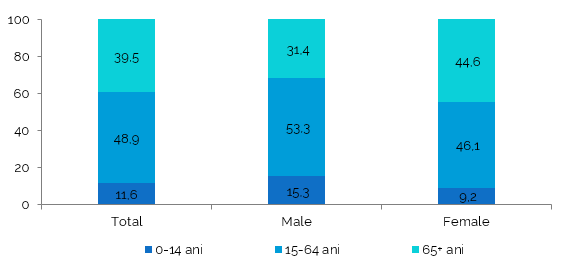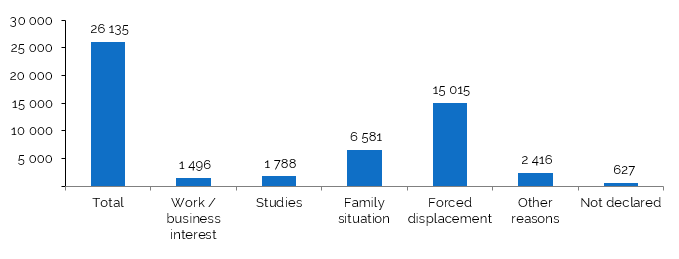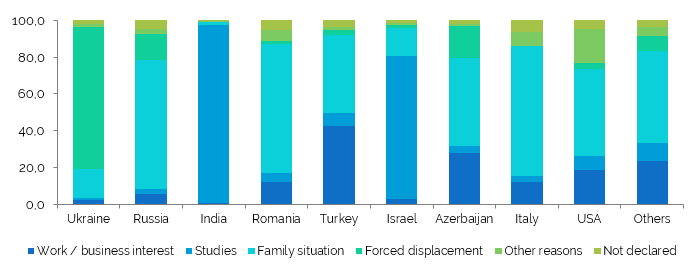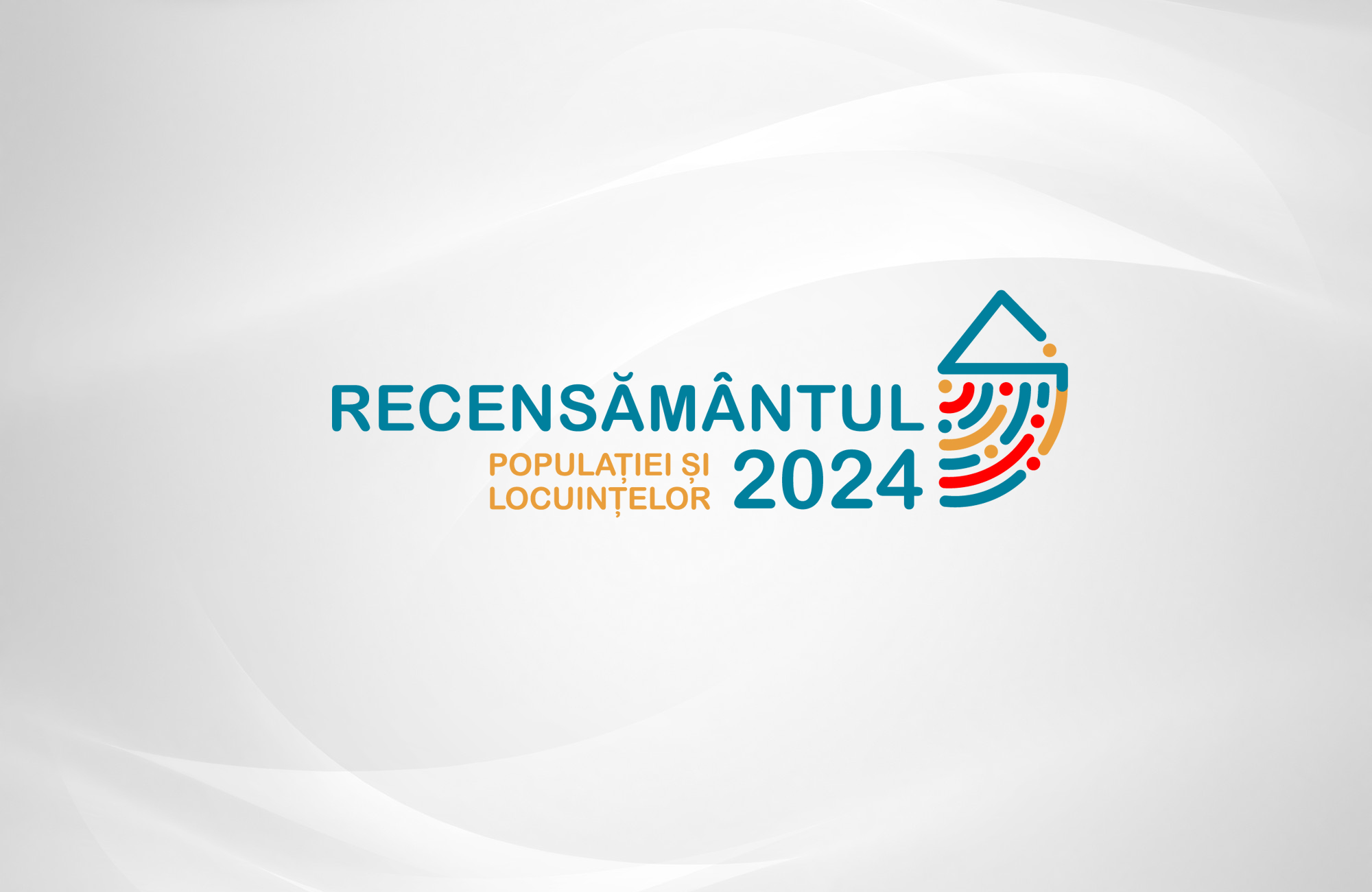The National Bureau of Statistics presents the final results of the 2024 Population and Housing Census (PHC) regarding the migration characteristics of the usually resident population as of the census reference date (April 8, 2024).
According to the final results of the 2024 PHC:
- 9.7% of the country’s population, or 233.3 thousand persons, changed their usual residence at the district/municipality level.
- Of the total number of persons born in other countries, 77.4% held Moldovan citizenship (including dual citizenship), 22.4% held the citizenship of another country, and 0.2% were stateless.
- At the census reference date, 30.8% of persons were living in the same dwelling since birth, 62.4% had lived there for 12 months or longer, and 6.8% ad lived in their usual place of residence for less than 12 months. A total of 9.7% of the country’s population, or 233.3 thousand persons, had changed their usual residence to another district/municipality.
Population by country of birth
Based on the country of birth, which determines a person's migration status, the population of the Republic of Moldova (RM), according to the 2024 census results, included several groups, namely: persons born in the country whose parents were also born in the Republic of Moldova - 2,148,200 persons (or 89.2% of the total population) persons born in the country with one parent born abroad - 106,600 persons (or 4.4%) or with both parents born in other countries – 26.6 thousand persons (or 1.1%), as well as persons born in other countries – 106.7 thousand persons (or 4.4% of the population) (Table 3.1 in the Annex, Figure 1).
Figure 1. Distribution of the population by migration status,
at the 2024 census, % of the total population

The population born in the Republic of Moldova to parents born abroad mostly hold the country’s citizenship, while 66.1% of persons born abroad had the citizenship of the Republic of Moldova (Figure 2).
Figure 2. Distribution of the population by migration status according to citizenship,
at the 2024 census, % of total population

Population born in other countries and its structure by age group,
sex, and citizenship
Of the total population with usual residence estimated at the 2024 census, 106.7 thousand persons (or 4.4%) were born in other countries, of which 65.1 thousand (or 61%) were female and 41.6 thousand persons (or 39%) were male (Table 3.2 in the Annex).
The distribution by major age groups of these persons born in other countries includes 12.4 thousand persons (11.6%) aged 0-14, 52.2 thousand persons (or 48.9%) aged 15-64 years, and 42.1 thousand persons (or 39.5%) were elderly persons aged 65 years and over.
The share of the male population born in other countries aged 0-14 was 15.3% and of men aged 15-64 years was 53.3%, which is 6.1 percentage points (p.p.) and 7.1 p.p. higher, respectively, higher than the share of the female population of the same ages. Meanwhile, the share of men aged 65 years and over (31.4%) was 13.2 p.p. lower than that of women in this age group within the total population born in other countries (Figure 3).
Figure 3. Share of the population born in other countries, by age group and sex,
in the 2024 census, %

Women born abroad had an average age of 55.2 years, which was 8 years higher than the average age of men in this population group (47.2 years) (Table 3.3 in the Annex).
Of the total number of persons born in other countries, 77.4% held the citizenship of the Republic of Moldova (of which 12.0 thousand persons had dual citizenship), 22.4% held the citizenship of another country, and 0.2% were stateless (Table 3.2 in the Annex).
Population aged 15 and over born in other countries by legal marital status
In the structure by legal marital status of the population aged 15 and over born in other countries, married persons accounted for 54.3%, never married persons accounted for 14.8%, widowed persons 16.8% and divorced persons 14.1% (Table 3.4 in the Annex).
Married persons predominated among men, accounting for 64.9%, compared to 48% among women. Widowed women, among persons born in other countries aged 15 and over were about three times more numerous than widowed men, accounting for 23.4% and 5.8% within the corresponding sex group.
The share of never married persons was 19.4% among men born in other countries, 7.3 p.p. higher than the share among women - 12.1%. The share of divorced men was 6.5 p.p. lower than that of divorced women (Figure 4, Table 3.4 in the Annex).
Figure 4. Structure of the population aged 15 and over born in other countries,
by legal marital status, by sex, at the 2024 census

Every second foreign-born person with usual residence in the Republic of Moldova at the 2024 census was born in Ukraine (49.1% or 52.4 thousand persons), while one in three persons was born in Russia (30.5% of those born in another country) (Figure 5, Table 3.5 in Annex).
Figure 5. Structure of the population born in other countries,
by country of birth, at the 2024 census, %

Children aged 0-14 predominated among the population born in countries such as the United Kingdom, France, and Italy (92.0%, 87.9%, and 65.7%, respectively). Persons aged 15-64 held the majority share among the population born in Romania (66.4%), Kazakhstan (64.4%), and Azerbaijan (58.8%). At the same time, more than one-third of people born in Ukraine, Azerbaijan, and Kazakhstan were aged 65 and over (Figure 6).
Figure 6. Structure of the population born in other countries,
by country of birth and age group, at the 2024 census, %

Foreign citizens by reason for being in the Republic of Moldova
According to the 2024 census, the usual resident population of the Republic of Moldova, holding only the citizenship of another state or those without any citizenship, represented 26.1 thousand persons or 1.1% of the total population. Among them, the majority (57.5% or 15.0 thousand persons) were on the territory of the Republic of Moldova due to forced displacement, followed by those whose reason was family situation (25.2% or 6,600 persons) (Figure 7).
Figure 7. Citizens of another country or stateless persons,
by reason for being in the Republic of Moldova, at the 2024 census, %

In terms of sex structure, females predominated, accounting for 54% (compared to 46% males), and in terms of distribution by place of residence, the majority (77.8%) lived in urban areas (Table 3.6 in the Annex). By age groups, the 15-64 years age category stood out, representing 69.9% of the total foreign citizens with usual residence in the Republic of Moldova (Table 3.7 in the Annex).
The main countries by citizenship were Ukraine (72.2% of all foreign citizens), followed by the Russian Federation (7.8%), India (4%), Romania (3.6%), Turkey (1.5%), Israel (1.2%), while other countries accounted for less than 1% each (Figure 8, Table 3.8 in the Annex).
Figure 8. Citizens of another country or stateless persons,
by country of citizenship, in the 2024 census, %

Based on the reason for being in the Republic of Moldova and by citizenship, the following categories of persons were distinguished: forced displacement - among Ukrainian citizens (76.7% of all Ukrainian citizens), mainly caused by the war in Ukraine; persons who came for studies - for citizens of India (96.7% of Indian citizens), as well as the reason related to family situation - for citizens of the Russian Federation (70% of the total), Romania (70.2%) and Italy (70.7%). Among those who stated the work/business interests as their reason, Turkish citizens were most prominent (42.5% of all Turkish citizens) (Figure 9).
Figure 9. Citizens of another country or stateless persons, by country of citizenship
and reason for being in the Republic of Moldova, at the 2024 census, %

The category of the population with forced displacement status included over 15,000 people, or 57.5% of all foreigners with usual residence in the Republic of Moldova at the reference date of the 2024 census (April 8, 2024). Among the forcibly displaced persons, women slightly predominated (57%), while the urban areas predominated as the place of residence (79.7%). By age group, those aged 15-64 prevailed, representing 62.1% (Table 3.6 in the Annex).
By type of housing, the majority of forcibly displaced persons (90.2%) lived in individual dwellings, while the remaining 9.8% lived in collective dwellings (Table 3.9 in the Annex).
By citizenship, the absolute majority were citizens of Ukraine (96.5%), with 61.7% being adults aged 15-64 and 30.8% children aged 0-14, the rest being citizens of the Russian Federation (1.9%) and other countries (Table 3.10 in the Annex).
Population by duration of usual residence
Data from the 2024 census on the population by duration of usual residence, show that 30.8% of people had lived in the same dwelling since birth, 62.4% for 12 months or more (but were not born there), and 6.8% had lived in the dwelling where they had their usual residence for less than 12 months (Figure 10, Table 3.11 in the Annex).
In the distribution of the population by length of usual residence, significant differences appear depending on the place of residence. Thus, in rural areas, 39.0% lived in the same dwelling since birth, and 54.8% had lived there for more than 12 months, while in urban areas only 21.4% had lived in the same dwelling since birth and 71.1% had had their usual residence for more than 12 months.
The share of those who had lived in their usual place of residence since birth was higher among men (35.1%) than among women (26.9%). With a share of 56.8% of men and 67.4% of women had their usual residence in the same dwelling for 12 months or more.
Figure 10. Distribution of the population by duration of usual residence,
by area of residence, %

Internal migration of the population by previous usual residence
According to the 2024 census data, 9.7% of the country's population, or 233,300 people, had changed their usual residence at the district/municipality level. The municipalities/districts with the highest shares of population whose previous had their usual residence (place of living) in another district/municipality are the municipality of Bălți, municipality, and the districts of Anenii Noi and Ialoveni — each with shares exceeding 15%. At the opposite end the administrative-territorial units with the lowest shares of population who had their previous residence in another district/municipality are the districts of Briceni, Cantemir, Ștefan Vodă, and ATU Gagauzia — all with shares below 6% (Table 3.12 in Annex, Figure 11).
Figure 11. Share of persons whose previous residence was in another
district/municipality by districts/municipalities, %

Annexes:
Notes:
1 The information is presented for the territory where the census was actually conducted within the framework of the 2024 PHC, i.e. excluding the administrative-territorial units on the left bank of the Nistru River, the municipality of Bender (including the village of Proteagailovca), Chițcani commune (including the villages of Mirenești and Zahorna), the villages of Cremenciug and Gâsca in Căușeni district, Corjova commune (including the village of Mahala) in Dubăsari district, as well as the village of Roghi within Molovata Nouă commune, Dubăsari district.
2 The usually resident population (the ”resident”population or URP) – represents the population that has lived predominantly in the country in the last 12 months prior to 08.04.2024 (the reference date of the census), regardless of temporary absences for the purpose of rest, vacation, visits to relatives and friends, business, medical treatment, or religious pilgrimages (Article 4 of Law 231/2022 on the population and housing census).
3 Marital status refers to the population aged 15 years and over.
Methodological notes:
The Population and Housing Census (PHC) is a complex statistical survey, whose primary objective is to produce official statistics on population and housing, comparable at the international level.
The 2024 PHC was conducted in accordance with national legislation, taking into account international recommendations, thus ensuring worldwide and regional comparability (including the recommendations for population and housing censuses of the United Nations (UN), the Conference of European Statisticians for the 2020 round of population and housing censuses, Regulation (EC) No. 763/2008 of the European Parliament and of the Council, etc.).
The reference time for the 2024 Population and Housing Census was 00:00 on April 8, 2024.
Within the framework of 2024 PHC, in order to ensure the completeness/coverage and accuracy of the data, a series of new methods and techniques were applied, compared to previous censuses, such as:
- Enumeration by interviewing persons at their usual place of residence using tablets (CAPI) and recording the declared responses through an electronic application. The use of digital technologies significantly improved the quality of the collected data, contributed to ensuring confidentiality, and accelerated the interview process.
- collection of the personal state identification number (IDNP) within the 2024 PHC allowed the combination and integration, for the purpose of producing official census statistics, of personal data collected directly from respondents and data collected indirectly from administrative sources and private data sources..
- The census period was extended to three months, compared to the previous PHC, which was limited to 14 days.
- Enumerators carried out at least five households visits in cases where there was no contact with the household.
- The diversification of census methods and techniques and the facilitation of participation contributed to improving population coverage in the 2024 PHC, including:
- Notification of the date of repeat visits by the enumerators
- Facilitating self-enumeration through online form completion on the NBS website;
- Operation of the PHC green line for interaction with the population
- Data collection in electronic format, through interviews assisted by electronic devices (CATI) or via the Internet (CAWI – for the enumeration of diplomatic and consular staff);
- Functioning of fixed census points during the last week of enumeration, offering the possibility for persons not yet covered to be enumerated at the premises of NBS territorial offices, etc
- Conducting the Post-Enumeration Survey (PRS) for the Republic of Moldova at the level of development regions, urban/rural areas, sex, and major age groups (in 2014, the PES was conducted only for Chisinau municipality) – for the evaluation of undercoverage in the PHC.
- Study for assessing the overcoverage of the PHC
- Use of administrative data sources (ADS) and the “signs of life” method to supplement data collected in the field and to estimate the total population of the country (including those not covered by the PHC).
Relevant information:

